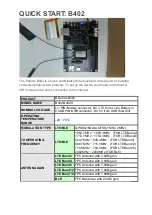
Additional information
11 of 31
Revision 4.0
2021-10-11
Recommendations for board assembly of Infineon transistor outline
type packages
Printed circuit board
For reliable solder joint formation of a gullwing lead the PCB pad should feature a certain backward extension
to the lead heel. According to the IPC-A-610 the minimum solder wetting height shall reach an extended line
projected from the lead tip top corner in parallel to the PCB pad plane [6]. As a rule of thumb often the line
parallel to the lead top plane is used to take into account the lower bend angle. The PCB pad and therefore the
solder paste print should have a distinct distance to the package mold in order to avoid an unclean solder
process as it is indicated by e.g. solder spatters.
An optimal PCB design depends on the specific application as well as on the specific design guidelines of the
chosen board manufacturer.
For further information about PCB pad design, please refer to the
General Recommendations for Board Assembly
of Infineon Packages
document that is available on the Infineon web page [1]. Please also feel free to contact
your local sales, application, or quality engineer.
2.3
Via-in-pad design
Thermal and electrical connections to the inner and/or bottom copper planes of the PCB are usually created by
plated through-hole vias in the board. The heat is then transferred from the chip over the package die pad and
the solder joint to the thermal pad on the board and further through the PCB by the thermal vias.
The diameter and the number of vias in the thermal pad depend on the specific thermal requirements of the
final product, the power consumption of the product, the application, and the construction of the PCB.
A typical hole diameter for thermal vias is 0.2 - 0.5 mm. An array with 1.0 - 1.2 mm pitch can be a reasonable
starting point for further design optimization. The implementation of thermal vias has several impacts on the
board assembly as outlined below. A constant increase of number of vias does not necessarily translate into a
constant decrease of the thermal resistance of the entire assembly set-up. Thermal and electrical analysis
and/or testing together with a proper board assembly design procedure are recommended to determine the
optimal number of vias needed.
One of the primary exposed pad design objectives, besides the thermal management, should be to avoid the
penetration of the vias by solder. Consequences of such solder wicking can be a decreased stand-off between
the PCB and the package, an increased void formation ultimately resulting in an insufficient solder joint area, or
surplus solder on the opposite side of the PCB.
A first approach for risk reduction should be the prevention of a direct print of solder paste on the via opening.
The stencil for large area prints such as on die pads is usually segmented. It is a good practice to position the
vias under the stencil sheet beams as shown in
. With such an approach, a good solder joint on a die
pad can be formed using vias that remain open on both sides of the board.
Despite this precautionary stencil design approach the solder can move into the via, driven by the wetting
forces. If the solder then protrudes to the opposite side of the PCB, it may interfere with a second solder paste
print process. To minimize the effect, wettable dummy areas surrounding the via opeing on the opposite side of
the board can catch the surplus solder to avoid beading and solder lumping.
In case the solder variance in volume below the die pad is too high due to the wetting of vias, they can be
closed by “tenting.” This process includes covering the vias by a solder mask (e.g. dry-film solder mask). If the
via tenting is done only on the opposite side of the board, the voiding rate will increase significantly. Another
method to close vias is called “plugging” (filling with epoxy), followed by overplating. Very small vias (100 µm in
diameter or smaller) should be filled with copper and overplated. In both cases, the specification of a planar
filling is necessary to avoid cavities that will trap gases, forming voids during reflow soldering.
In case it is not necessary to provide a direct connection from the solder pad under the exposed die pad to the
inner layers of the PCB, the vias can be placed next to the footprint near the package and covered with solder
mask.












































